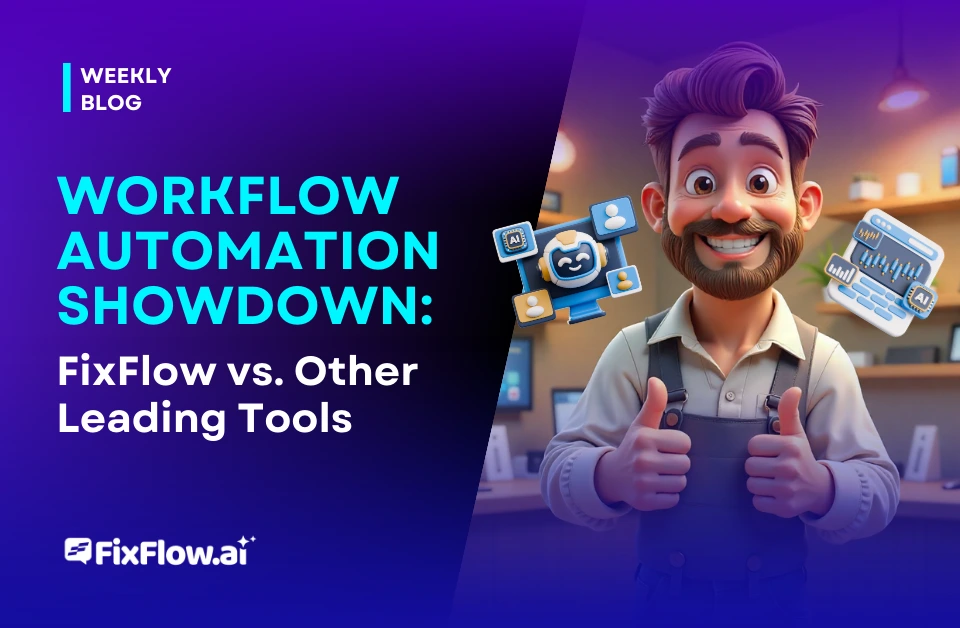Workflow Automation Showdown: FixFlow vs. Other Leading Tools
FixFlow offers a more intuitive workflow automation experience than market leaders, with a streamlined interface and robust core integrations that prioritize depth over breadth. You’ll find its trigger-action system simpler while still handling complex workflows efficiently. Unlike competitors that overwhelm with options, FixFlow delivers faster implementation (within two weeks) and proven ROI, reducing bottlenecks by up to 73%. Our detailed comparison reveals which solution truly delivers the best results for your business.
Core Functionality Comparison: FixFlow vs. Market Leaders
When evaluating workflow automation platforms, core functionality serves as the foundation for any meaningful comparison. In our workflow automation comparison, FixFlow stands out with its intuitive process mapping and bottleneck identification features specifically designed for SMBs. Unlike Zapier’s focus on integrations or Monday.com’s project management emphasis, FixFlow prioritizes streamlining internal workflows.
While Jira offers robust solutions for tech teams and Asana excels in collaboration, FixFlow delivers a balanced approach combining automation power with accessibility. You’ll find its trigger-action system more straightforward than competitors’, yet capable of handling complex workflows. In the FixFlow vs leading workflow tools analysis, what becomes apparent is FixFlow’s efficiency in addressing the specific automation needs of growing businesses without overwhelming them with enterprise-level complexity.
User Experience & Interface Design Across Platforms
The user interface stands out as perhaps the most critical differentiator when comparing workflow automation platforms. When evaluating FixFlow against competitors, you’ll notice its clean, minimalist approach that prioritizes usability and onboarding. While Zapier offers powerful functionality, its interface can overwhelm new users with options. Monday.com provides a visually appealing experience but includes numerous features you might never use.
FixFlow strikes a balance by presenting only what you need, no complex menus or redundant options. This intentional design choice accelerates the learning curve, enabling teams to build workflows within minutes rather than days. The platform’s consistent interface across devices guarantees you’ll have the same seamless experience whether on desktop or mobile, a consideration often overlooked in competing solutions.
Integration Ecosystem: Connectivity & Compatibility Analysis
Connectivity forms the backbone of any effective workflow automation solution in today’s fragmented software landscape. When evaluating FixFlow against competitors, you’ll notice significant differences in their integration ecosystems.
FixFlow offers solid connectivity with common business tools, prioritizing depth in core integrations rather than breadth. While Zapier dominates with 3,000+ app connections, FixFlow focuses on robust, native integrations with essential platforms like Salesforce, Google Workspace, and Microsoft 365.
This compatibility analysis reveals a strategic difference: FixFlow guarantees seamless data flow between fewer platforms but with greater reliability. At the same time, competitors like Monday.com provide more extensive connection options, but sometimes with less sophisticated implementations. Your choice depends on whether you need comprehensive coverage across many apps or deeper integration with specific business-critical systems.
Pricing Models & ROI Assessment for Businesses of All Sizes
Every dollar invested in workflow automation must deliver measurable returns, making pricing models a critical differentiator between FixFlow and competitors. FixFlow offers transparent, value-based pricing with fewer hidden costs than enterprise-focused alternatives like Jira or Monday.com.
When evaluating the roi of automation platforms, consider not just monthly fees but implementation costs, training time, and scalability expenses. FixFlow excels for SMBs with its straightforward pricing structure that grows with your business without penalizing expansion.
Unlike Zapier’s connection-based limitations or Asana’s feature-gating across tiers, FixFlow’s approach to pricing and ROI emphasizes immediate value. You’ll typically see workflow efficiency improvements within weeks rather than months, creating a faster path to positive return on investment.
Real-World Performance: Case Studies & Implementation Success Stories
While theoretical comparisons provide valuable insights, examining real-world implementations reveals FixFlow’s practical advantages over competitors. A mid-sized marketing agency reduced approval bottlenecks by 73% after switching from Trello to FixFlow, completing campaigns 40% faster. Similarly, a healthcare provider integrated FixFlow’s business process management software with their EMR system, cutting administrative tasks by 62%.
Unlike Monday.com users who reported complexity challenges during onboarding, FixFlow implementations typically launch within two weeks. One manufacturing firm simultaneously maintained Asana for project tracking while adopting FixFlow for automated workflows, eventually consolidating to FixFlow exclusively after seeing 27% higher team productivity rates. These success stories demonstrate FixFlow’s superior real-world performance across diverse industry applications, particularly for organizations seeking rapid implementation without sacrificing functionality.
Frequently Asked Questions
How Long Does Implementation Typically Take for Each Platform?
Implementation timeframes vary profoundly across platforms. You’ll get started with FixFlow in days, not weeks, with its streamlined setup. Zapier typically takes 1-3 days for basic workflows. Monday.com and Asana require 1-2 weeks for team adoption. Trello is quickest at just 1-2 days for simple boards. Jira is the most complex, often needing 3+ weeks for proper configuration. Your technical resources and workflow complexity will ultimately determine your exact timeline.
Can I Migrate Existing Workflows From Another System?
Yes, you can migrate existing workflows from another system. FixFlow offers migration tools that make transferring your processes relatively simple. Most competitors like Monday.com and Zapier also support migrations, though the ease varies. You’ll typically need to export your workflow data as CSV files or use API connections. The migration complexity depends on your current system’s structure, but most platforms provide documentation to guide you through the process.
What Security Certifications Do These Automation Tools Hold?
Security certifications vary across workflow automation tools. FixFlow maintains SOC 2 Type II compliance and GDPR standards. Zapier offers SOC 2 Type II and GDPR compliance. Monday.com holds SOC 2, ISO 27001, GDPR, and HIPAA certifications. Asana maintains SOC 2, ISO 27001, and GDPR compliance. Trello (through Atlassian) has SOC 2, ISO 27001, and GDPR. Jira offers the most exhaustive security with SOC 2, ISO 27001, GDPR, HIPAA, and FedRAMP certifications. You’ll want to verify current certifications directly.
Do These Tools Offer Offline Functionality?
Most workflow automation tools like FixFlow, Zapier, Monday.com, Asana, Trello, and Jira operate primarily online as cloud-based services. You’ll generally need internet connectivity to access their full functionality. At the same time, some offer limited offline capabilities (like Trello’s basic card viewing or Asana’s mobile offline mode), you’ll typically find that core automation features remain unavailable offline. For critical processes, you’ll want to guarantee a reliable internet connection for consistent access to these tools.
How Do These Platforms Handle Compliance Requirements?
When it comes to compliance requirements, you’ll find varying levels of support across these platforms. FixFlow offers basic compliance features suitable for SMBs, while enterprise tools like Jira provide more robust compliance frameworks. Monday.com and Asana include audit trails and permission settings. Zapier has SOC 2 compliance, but may require additional configuration. Before choosing a tool, you’ll need to assess your specific regulatory requirements and match them to each platform’s compliance capabilities.







